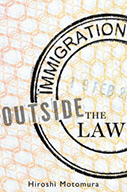Immigration Outside the Law

Author: Hiroshi Motomura
Publisher: New York; Oxford, UK: Oxford University Press, 2014. 360p.
Reviewer: Gabriel J. Chin | July 2015
Hiroshi Motomura, one of the foremost contemporary scholars of immigration law, has written an immensely thoughtful and provocative book. It is essential reading for anyone interested in the subject of immigration. While Professor Motomura is a recognized founder of the field of immigration law, he is also a policy entrepreneur; in 2012, he organized and authored a legal scholars’ letter to President Obama which proved to be a critical support for the Deferred Action for Childhood Arrivals executive relief program. It is no surprise, then, that Motomura’s book should contain such an intriguing mix of history, analysis and policy proposals .
The book is framed using the 1982 Supreme Court case of Plyler v. Doe. In Plyler, the Court, 5-4, held that Texas could not deny children who were unauthorized migrants a free K-12 education. Three things flow from the decision. The first is that unlawful presence in the United States, deportability, does not deprive a person of all legal rights. Second, the decision makes clear that the federal government, not the states, is principally responsible for immigration enforcement. Third, the decision rests in part on the prediction? that unauthorized migrants would , as a factual matter, remain in the United States. This turned out to be correct, as the children involved in the litigation were allowed to stay in the United States because of the Immigration Reform and Control Act of 1986.
And yet, the book recognizes that the effects of Plyler were momentary; it resolved a particular dispute without solving the problem of unauthorized migration. The power to make noncitizens’ lives difficult, largely denied to the states, remains in the hands of the federal government. Even as to the states, equality extended no further than high school graduation, leaving the children we now know as DREAMers in limbo with respect to higher education and employment. And Plyler is controversial; there is serious doubt that the Court would come out the same way if it had to decide again. The book is essentially an argument that Plyler got it right, but did not go far enough.
Chapter 1 points out that there are no neat divisions between legal and illegal status. First, millions exist in a “twilight status;” parolees and those in Temporary Protected Status could be deported at some point, but for the moment are formally allowed to stay. In addition, “[e]ven when a noncitizen’s presence in the United States clearly violates immigration law, that status may change.” (22) This is because there are several legal mechanisms for those who are deportable to avoid deportation.
The book argues persuasively that “unlawful presence is inconclusive by design.” (52) There are several reasons for this. First, undocumented migration benefits consumers and employers; therefore, at least at times, society does not want too little of it. Second, deporting people who are part of America’s social and economic fabric would be cruel. Accordingly, Congress by statute has instructed executive agencies to use discretion when enforcing the law, and requires them to be selective by giving them only enough money to deport a fraction of those that the law on the books says they could.
A central theme of the book is that the phenomenon of unauthorized migration traces to race-based decisions. From 1790 to 1952, the privilege of naturalization was restricted by race. From 1875 to 1965, immigration was restricted by race. The first “illegal immigrants” were Chinese laborers, immigrating in violation of the Chinese Exclusion Act. Asian Exclusion became increasingly systematic, culminating in 1924: “with each new restriction on Asian immigration, the demand for Mexican workers intensified.” (38) White noncitizens were welcomed and aided as “Americans in waiting”; nonwhites, even citizens, were sometimes here in a precarious status. From the “Mexican repatriation” of the 1930s to the streamlined deportation procedures now in place, thousands of non-white U.S. citizens have been illegally deported (thus the double entendre of the title).
The book is skeptical of state immigration enforcement. Chapter 2 notes that states have adopted a range of enforcement mechanisms, from indirect discouragement (through, say, denial of state benefits), local assistance with federal law enforcement efforts, and state laws directly criminalizing immigration violations. Federal courts have struck down most forms of state regulation, on the principle that immigration is an exclusive federal power. On the other hand, some states and localities have attempted to integrate undocumented non-citizens into their communities, for example, by offering ID cards, or in-state college tuition. Courts have declined to void these actions.
Chapters 4 and 5 applaud the division of authority recognized by current law, in large part because state immigration enforcement would create the risk of racial discrimination in enforcement with no practical way to smoke it out. The rights of citizens and residents suspected of being undocumented would be imperiled. Even when focusing on those actually deportable, some localities might well pay special attention to non-whites. While the federal government’s history of discrimination in this area is also robust, at least federal actions are more visible and accountable. By contrast, state actions mitigating the plight of the undocumented do not override federal decisions, as would, say, a state deporting someone when the federal government has taken no action. State actions designed to integrate also do not risk covert racial discrimination. Accordingly, the book argues, they are unobjectionable.
Overall, though, relief for those here now—if any—and a plan for going forward will have to come from Congress. Chapter 3 explores arguments about the status of unauthorized migrants. Once again, given the history of racism in US immigration policy, the book is skeptical of the turn toward enforcement in recent decades. When the immigrant stream was overwhelmingly white, relief was more readily available. Now that the immigrant stream is overwhelmingly non-white, the law no longer looks at even lawful permanent residents as “Americans in waiting.”
Given the history of a discretionary immigration enforcement policy with many instances of categorical relief granted by law, and individual relief authorized on a case-by-case basis, it is hard to take seriously arguments that the “rule of law” requires total enforcement. The rule of law is not offended even if most highway traffic is six miles above the speed limit. Discretion is part of the rule of law; once the law decides to authorize presence, the migrants are no longer unauthorized.
The book offers two theoretical justifications for relief for unauthorized migrants. The first is “immigration as contract,” the idea that many came to the US with the tacit permission of the government, and provided benefits to the economy and to the society with an expectation that they would be allowed to stay. The second is “immigration as affiliation,” that many undocumented people have developed connections to the US and made contributions here that our law recognizes as meaningful.
To its credit, the book engages counter-arguments and recognizes that some will find these justifications wanting. The “deportationist” view of people like former UMKC law professor and current Kansas Secretary of State Kris Kobach, architect of many restrictive state and local laws, is that any such period of acquiescence ended by policies such as the 1986 Immigration Reform and Control Act’s criminalization of hiring unauthorized workers, and the 1996 law imposing a ten year bar on entering the United States if here unlawfully for a year or more. Yet, any claim of non-acquiescence must account for the fact that there are many more undocumented workers here now than there were in 1986. And while the book recognizes that policies can change, it insists that in fairness people who relied on old policies must be accommodated.
That there could be a legitimate comprehensive immigration reform does not mean that its contours are straightforward. Chapters 6 and 7 embrace the daunting challenge of finding a solution, and one which will not simply generate a new immigration crisis in a decade or so.
The book proposes a temporary worker program, with a path to citizenship. It also envisions relaxing or eliminating per-country limitations, which now provide that no country’s natives can receive more than 7% of available immigration visas. The per-country cap creates backlogs in nations of high immigration demand, such as Mexico, China, India, and the Philippines. The book also suggests making it easier for workers without a college degree to immigrate. For those already here but out of status, some of these changes could be retroactive, and existing relief mechanisms could be expanded to allow those to remain who have been here for years and have close ties to the US.
While the arguments are principled and persuasive, enactment and implementation of a reform program ultimately raises political questions, that is, some of the proposals are reasonable, but are not necessarily the only reasonable solutions. For example, even for those who find key concepts compelling, such as “immigration as contract” and “immigration as affiliation,” one response would be to limit, going forward, the numbers of people with contracts and affiliations. Migrants who have contracts and affiliations now must be accounted for, but enforcement could constrain the expectations of future unauthorized migrants.
Also, while the book does not purport to advance a systematic theory of the right to immigrate, its policy reforms implicitly take into account the interests of those outside U.S. borders. Members of Congress from both major parties are likely to craft immigration policy with an eye toward benefitting the US. In addition, if the aim is to help those in need in foreign countries, it is not clear that immigration is the best method compared to other forms of foreign aid. While nondiscrimination on race and other grounds is an important legal and social principle in the United States, discrimination based on education and ability is not taboo. Many educational and employment opportunities are restricted based on ability to pay and qualifications; if Stanford or Google can select based on elite credentials, it is not clear why justice requires that immigration visas (other than in the refugee context) be made available to the poor. One could conclude that many or all unauthorized migrants here now are “Americans in waiting,” while denying that status to people overseas.
Finally, I do not entirely share the book’s hope for a permanent solution. Since the US has had immigration regulation, it has had unauthorized migration, both because the US has been an attractive nation to live and work, and because it has not been a police state. I hope both of these remain true, even if that forces America to make reasonable and fair judgments about people who may be here outside the law, but contribute to the nation.
Gabriel J. Chin, Professor of Law & Martin Luther King, Jr., Hall Research Scholar, UC Davis School of Law


